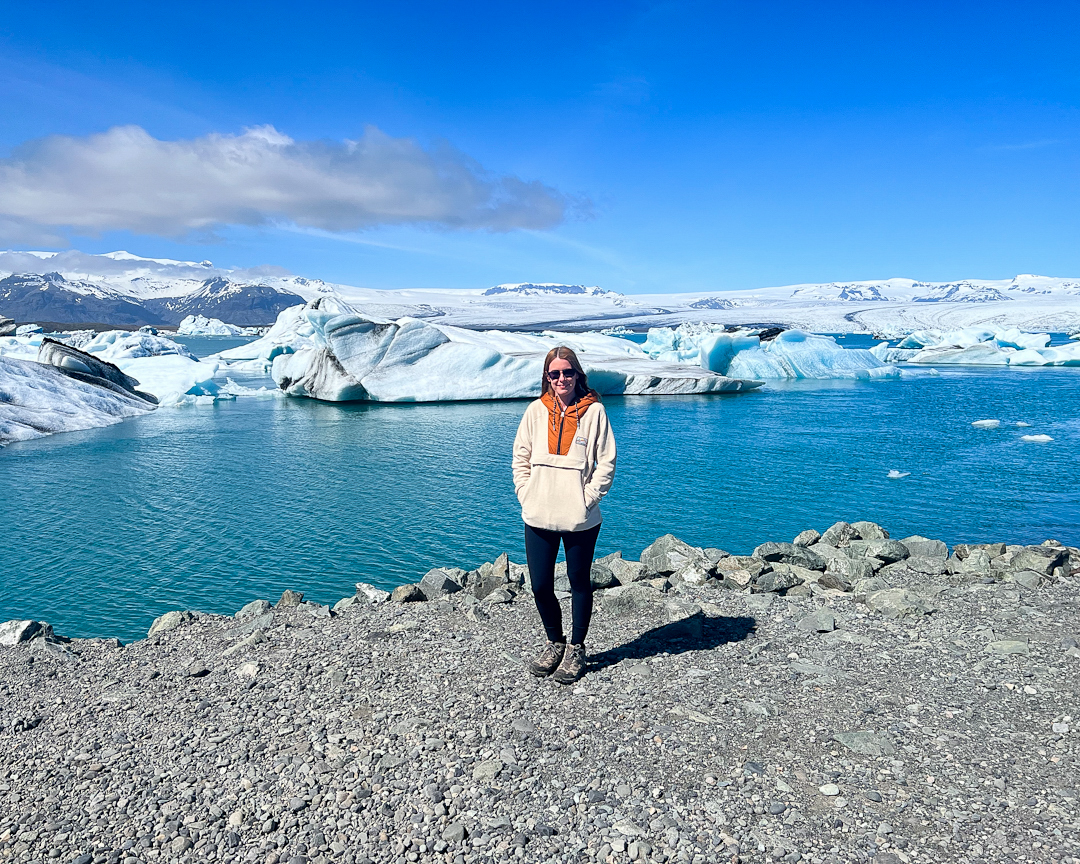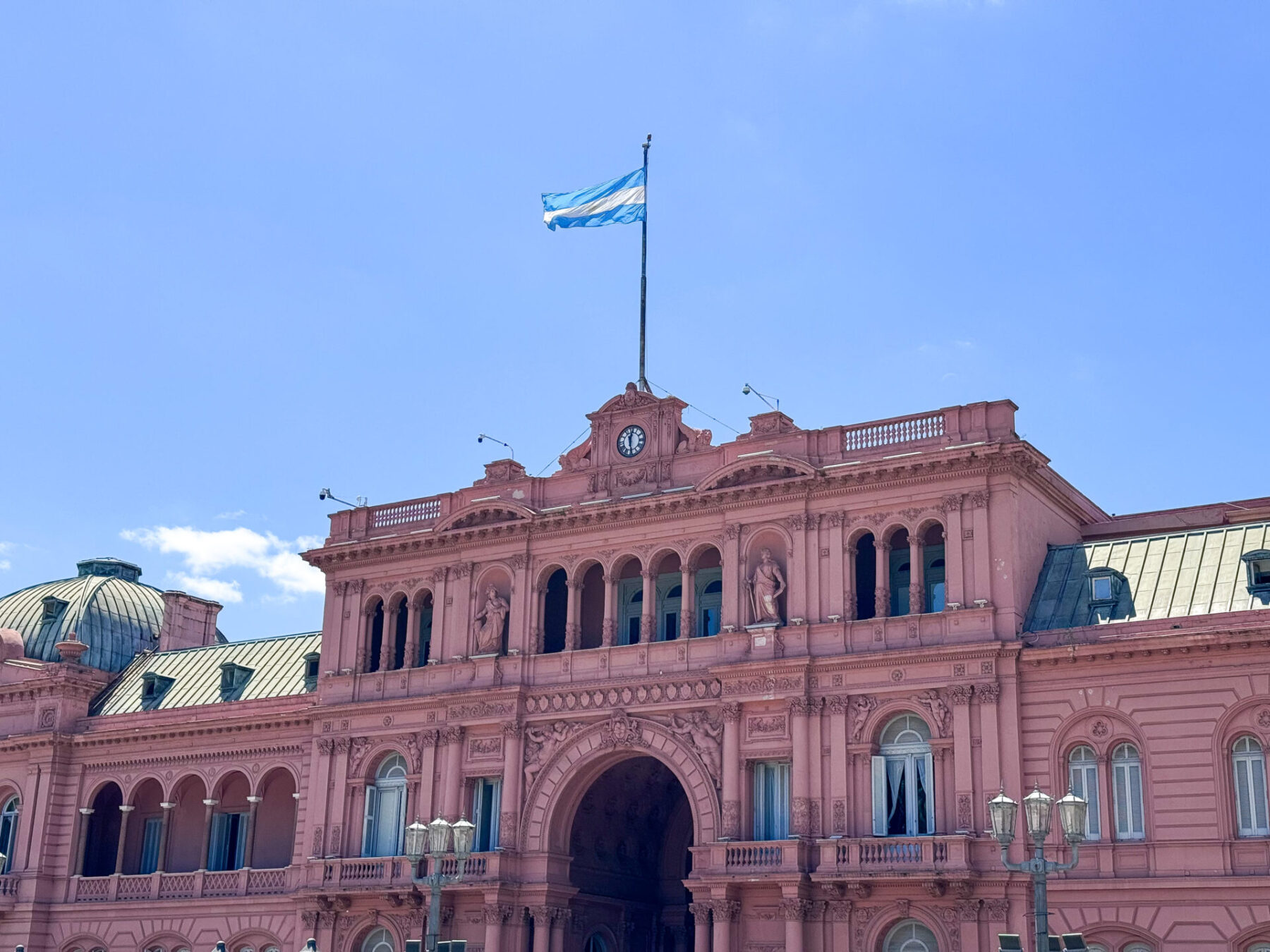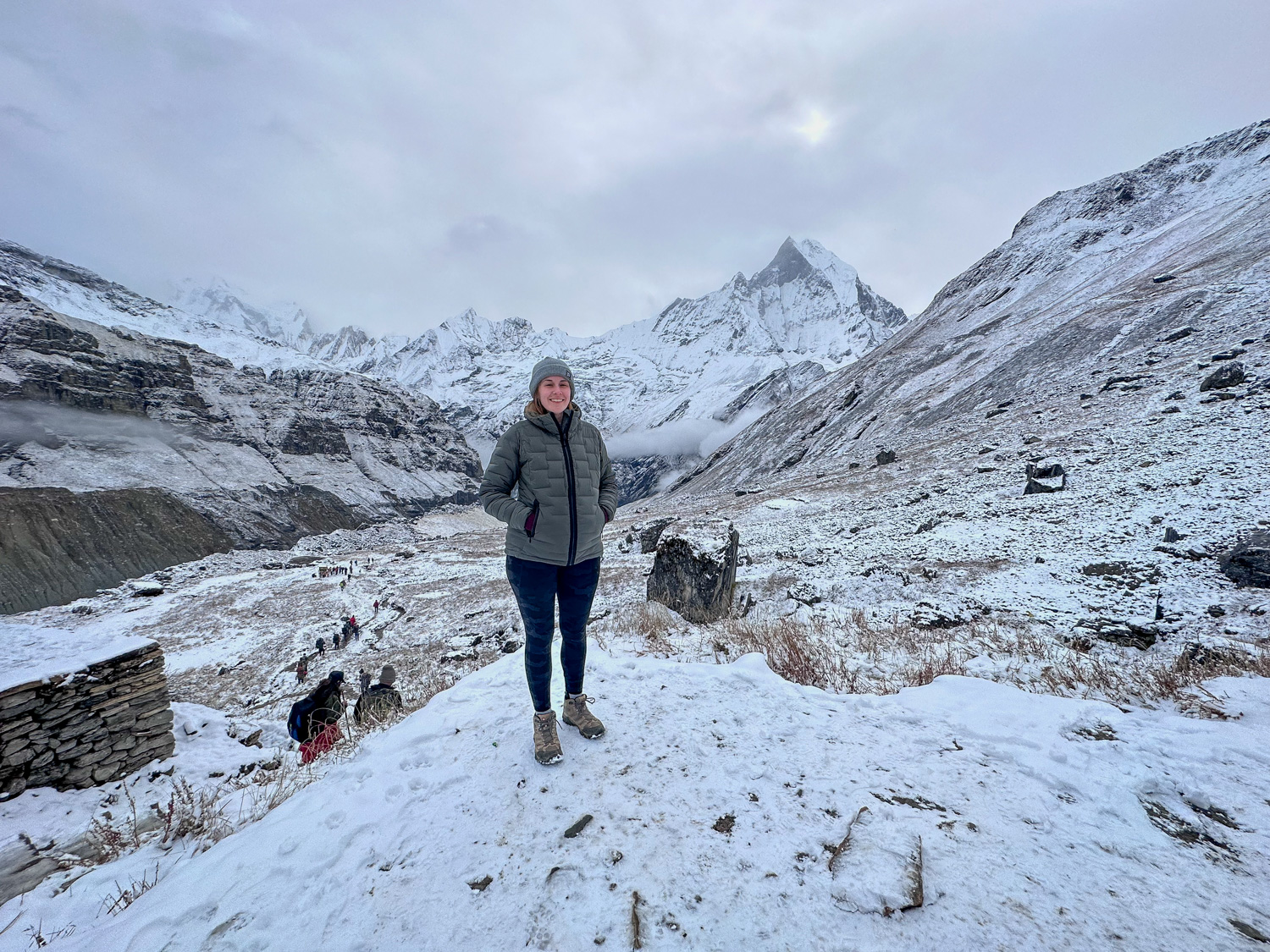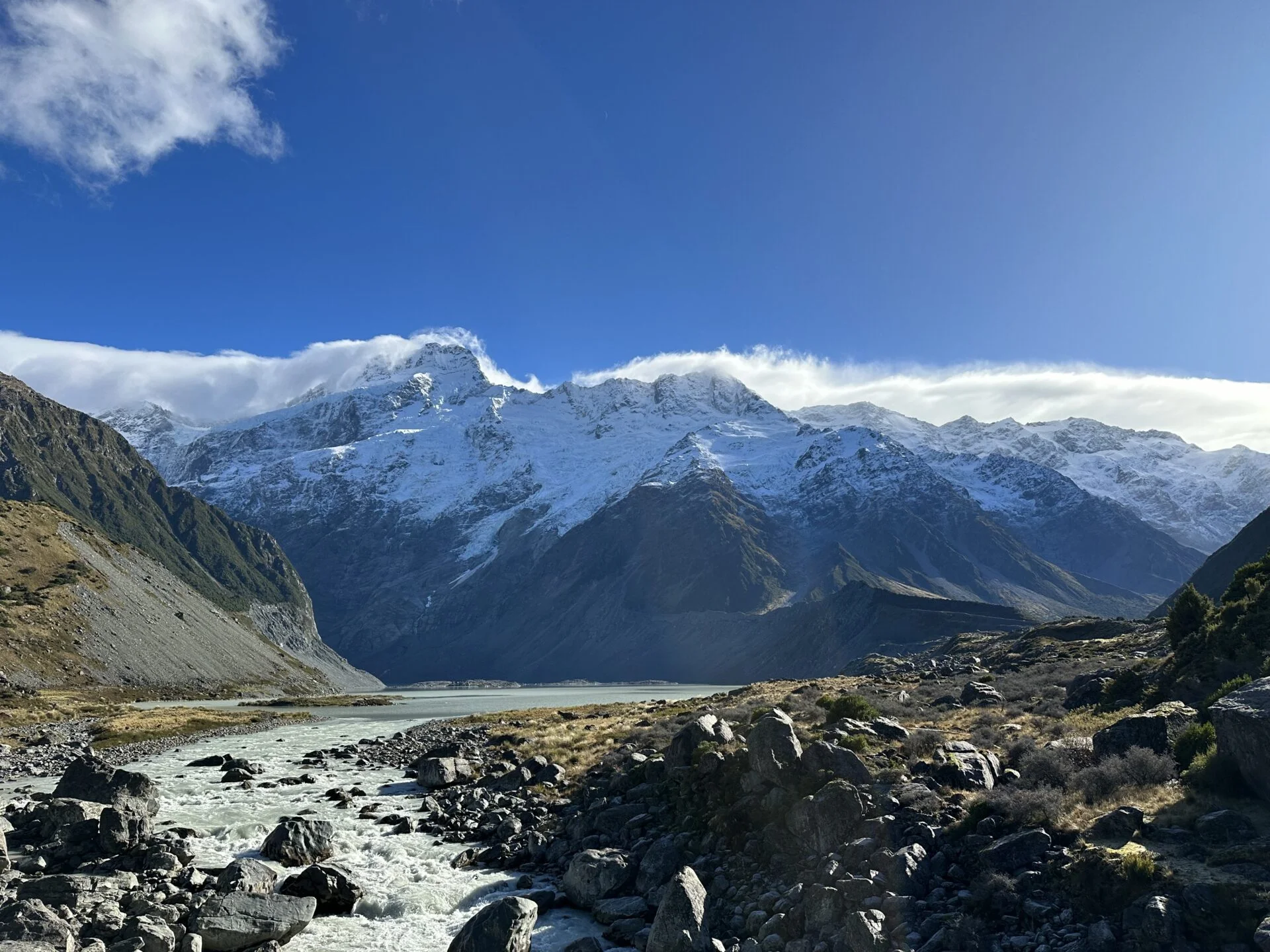Argentina is one of the most popular South American countries for backpackers. With vibrant cities, epic hiking, magnificent glaciers, classic vineyards and diverse wildlife, Argentina really has something for everyone.
In this post, I’ve shared all you need to know about planning a backpacking trip to Argentina. This includes how long to spend in Argentina, the best places to visit, a rough budget guide, how to get around Argentina and the best time of year to visit.
I spent a long time planning and researching my solo trip to Argentina. After years of waiting, I finally got to spend a month backpacking around Argentina. The country has become one of my favourite countries in the world, and I can’t wait to return there soon and explore more of this wonderful country.
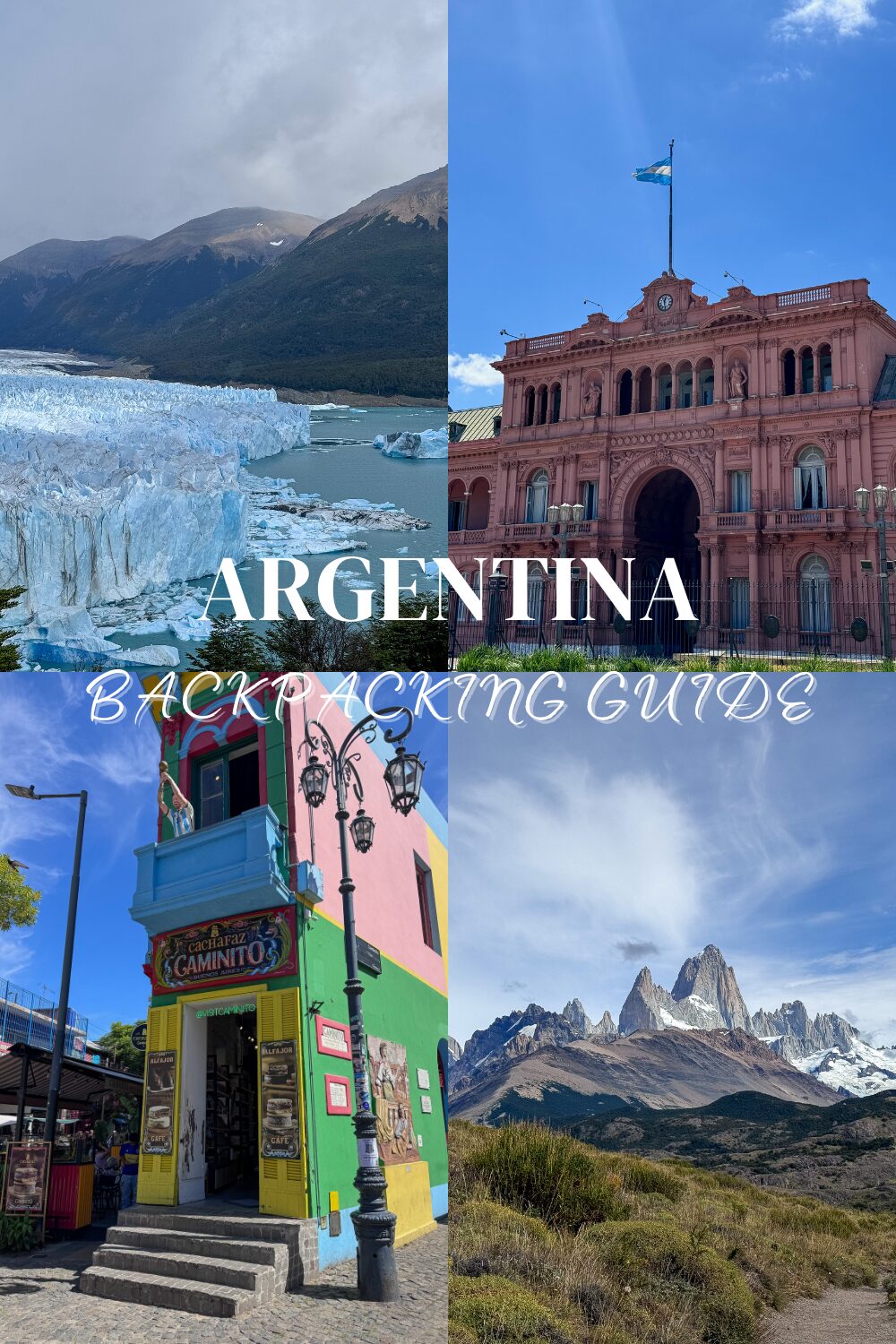
Despite attracting millions of tourists every year, Argentina isn’t the easiest country to navigate. Many of the popular destinations worth seeing are far apart, and the country is also experiencing an economic crisis.
I spent over four weeks backpacking in Argentina and have shared everything I learned in the post below. I hope it helps you to plan your dream trip to Argentina.
How long to spend in Argentina?
I spent a whole month backpacking Argentina, but it didn’t feel like long enough. Argentina is the 8th largest country in the world and is filled with incredible things to do and unique places to explore.
If you’re building Argentina into a bigger South American backpacking itinerary, I would suggest planning to spend at least one month backpacking Argentina. This will give you time to explore Buenos Aires, go hiking in Patagonia, and check out a few other popular destinations.
For those with more time on their hands, you could easily spend longer than a month in Argentina. Likewise, it’s possible to see the highlights in less than a month. You’ll just have to narrow down the places you really want to visit.
The best time of year to visit Argentina
Argentina can be visited all year round, but certain seasons certainly have their benefits. As a general rule of thumb, the shoulder seasons of spring and autumn are the best time to visit Argentina.
Being in the Southern Hemisphere, Argentina’s seasons are the opposite of what you might be used to. Argentina’s winter is from June to September, and the summer months are from December to March.
If hiking in Patagonia is part of your Argentina itinerary, then December to March will be your best option. This is the high season which means more crowds, but it’s also when the hiking trails are accessible. The shoulder season months of November and April are a great option to avoid the crowds, but be prepared for cold weather. During the winter months, many of the hiking trails are covered in snow and inaccessible.
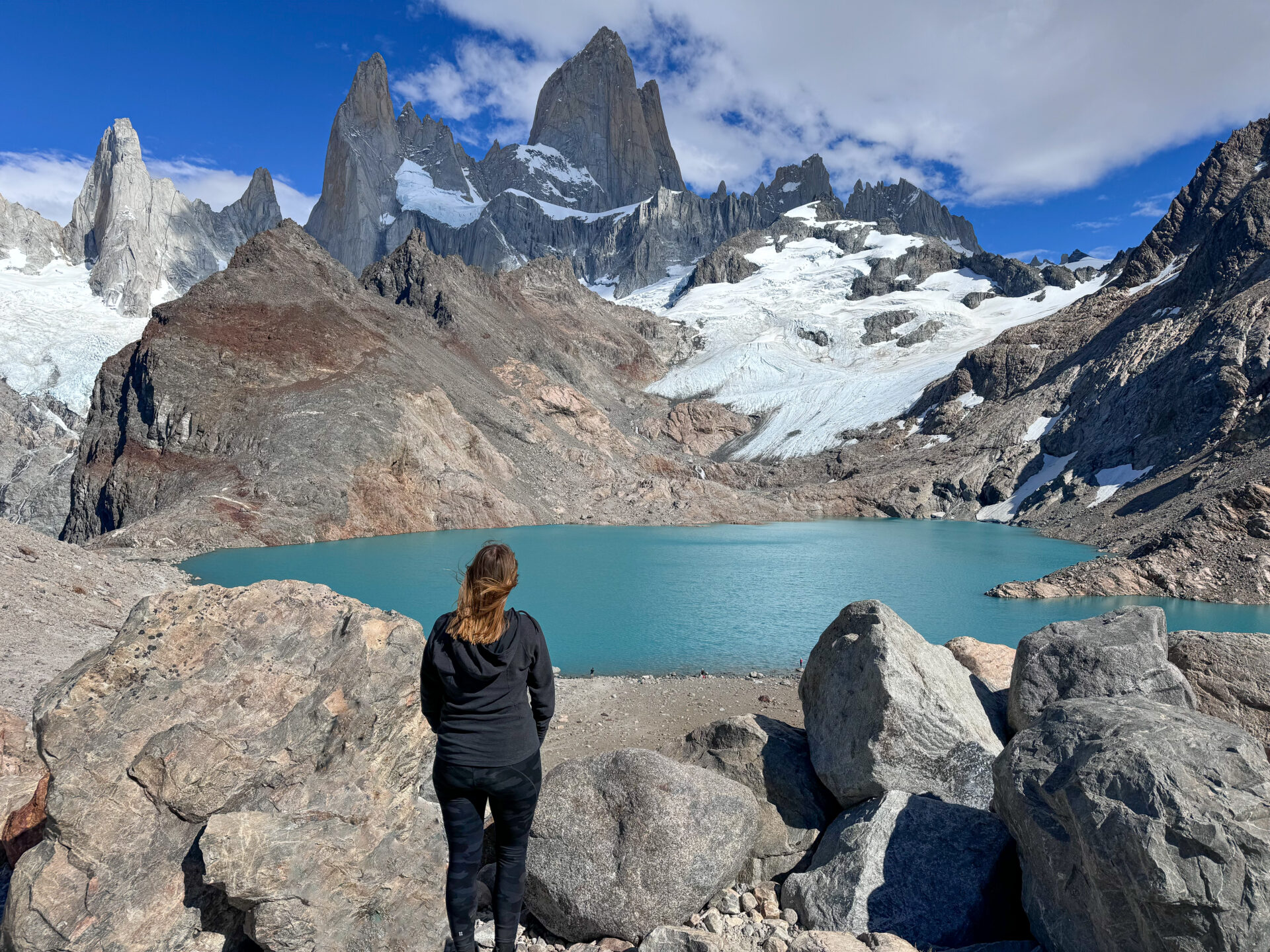
Buenos Aires can get very hot, humid and crowded during the summer months; the same can be said for Iguazu Falls. This is why visiting Argentina in the spring or autumn is the best option.
Up in the North of Argentina, autumn is a wonderful time to visit. The beautiful autumn colours put on a stunning show, and harvesting begins in Mendoza.
I was in Argentina for February and March. The temperatures weren’t too extreme, and I was very lucky with the weather. The hiking trails were all still very much accessible too.
The best backpacking destinations in Argentina
Argentina is a HUGE country with so much to explore. Narrowing down where to include on your Argentina itinerary can be a tough task, but here are a few ideas.
Buenos Aires
Buenos Aires is the capital of Argentina and an absolute must-visit on your backpacking trip. I fell in love with the city and ended up staying an additional two weeks.
Known as the ‘Paris of Latin America’, this cultural hub is filled with history, delicious food and exciting things to do. From the traditional streets of San Telmo to the vibrant La Boca, Buenos Aires has something for everyone.
I recommend spending at least three days in Buenos Aires, but if you’re short on time, you can see the city’s highlights in just one day. The city has great public transportation, so it’s fairly easy to get around the city without spending a fortune.
While in Buenos Aires, be sure to catch a famous Tango show, try some traditional Argentinian food and visit the historic Plaza de Mayo.
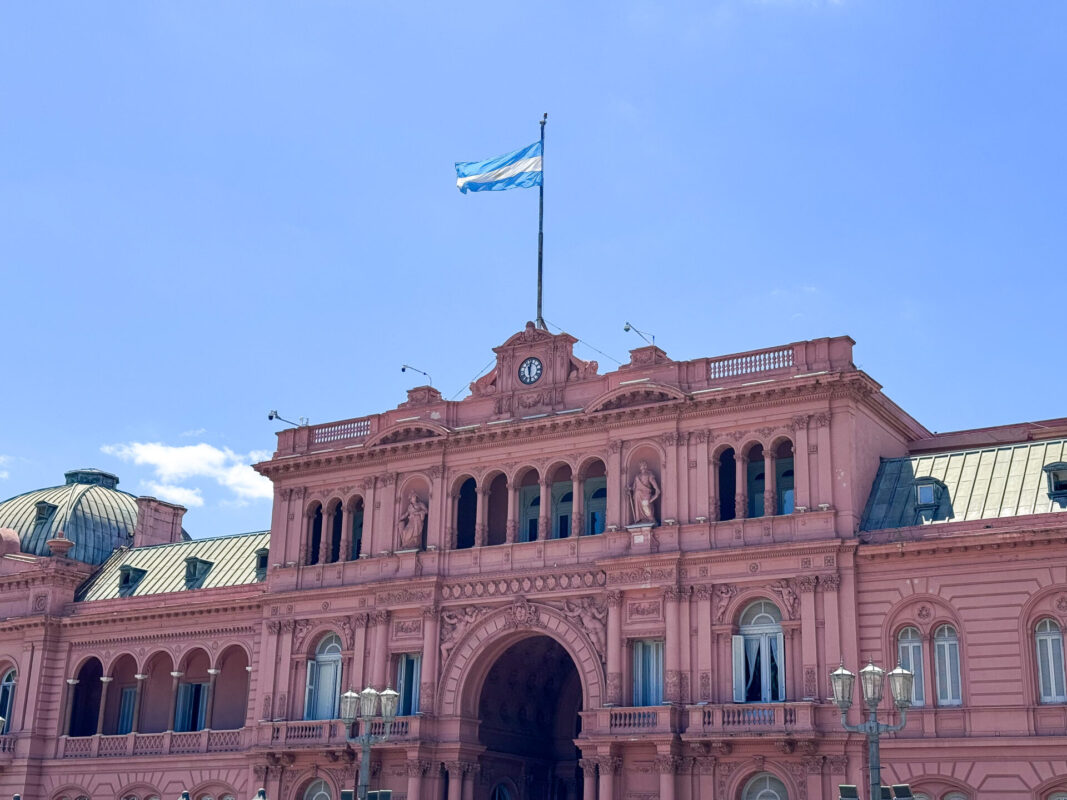
Patagonia
Argentinian Patagonia is an absolute must on any backpacking trip to Argentina. It is a large and vast area that spans parts of both Chile and Argentina. It’s one of the most beautiful places I have ever visited.
The two main destinations in Argentinian Patagonia are the towns of El Calafate and El Chalten. El Calafate is a great starting point for your trip through Patagonia. The lively town is the gateway to Los Glaciares National Park and is close to the famous Perito Moreno Glacier, one of the most popular natural attractions in Patagonia.
While in El Calafate, don’t miss the lesser-known Leona Petrified Forest. This desert area is filled with petrified trees and dinosaur fossils. It’s unlike anywhere else I visited in Argentina. It can only be visited as part of a guided tour.
Two hours down the road is the small town of El Chalten. Nestled in the snow-capped mountains, El Chalten is incredibly beautiful and home to several hiking trails. This includes the iconic Mount Fitz Roy trail and the popular Laguna Torre trek.
Further north is the Lake District of Argentina, San Carlos de Bariloche. The area is also home to some incredible walks.
If you are keen to include Patagonia on your backpacking trip to Argentina, make sure you are choosing the right time of year. A great time to visit is between December and March, when the trails are most accessible. If you want to avoid the crowds, consider November or April. Many of the hikes are inaccessible during the winter months (May – October).

Iguazu Falls
Iguazu Falls is one of the Seven New Natural Wonders of the World. Taller than Niagara Falls and wider than Victoria Falls, visiting this impressive spot is one of the best things to do in Argentina.
Iguazu Falls spans both Argentina and Brazil, and it’s worth seeing the Brazilian side if you have the chance. In fact, it’s a great place to cross the border and continue your backpacking route for Argentina and Brazil.
To reach Iguazu Falls, you’ll need to fly from Buenos Aires in Argentina or one of the major cities in Brazil.
Iguazu Falls attracts millions of visitors every year. The high season runs during the summer months, and it can also get very busy during this period. If you can, try and visit outside of December to April.
Mendoza
Located in northern Argentina, Mendoza is known for its vineyards and wine tasting. This beautiful area is a great place to visit if you want to go wine tasting or experience the Argentinian countryside.
Most backpackers visit Mendoza by flying in from Chile or Buenos Aires. If you’re not bothered by trying wine, I wouldn’t prioritise a visit here (although it’s still very beautiful).
Salta
Did you know Argentina has its own Rainbow Mountain? Well, in Salta, you’ll find Quebrada de Humahuaca, a colourful mountain valley.
Found in the north of the country, the Salta area of Argentina boasts a completely unique and different side of the country. Here, you’ll also find Argentina’s very own salt flats known as Salinas Grandes.
The area is a little bit off the beaten path, but it’s definitely worth visiting if you have the time.
Discover the best things to do in Salta.
Ushuaia
Fondly named ‘Fin del Mundo,’ Ushuaia is the southernmost city in the world. Most people head to Ushuaia to board an expedition ship to Antarctica, but the area has a few other places worth visiting.
The main attraction of Ushuaia is the famous Tierra del Fuego National Park. This diverse archipelago and national park is home to some incredible wildlife and raw beauty. If you’re visiting Ushuaia, make sure to include a visit here. There are several options for day trips or you can make your own way there and hit one of the many hiking trails.
One of the most famous parts of Tierra del Fuego is the Beagle Channel. This strait is a wildlife haven and home to penguins, seals, and sometimes dolphins and whales. Several tour operators offer boat trips around the area.
You don’t need to spend much time in Ushuaia – three days would be plenty. It’s worth noting that it’s very out of the way and requires either a flight or a long bus journey to reach. I believe Ushuaia is worth visiting, but it shouldn’t be prioritised over time in Patagonia.
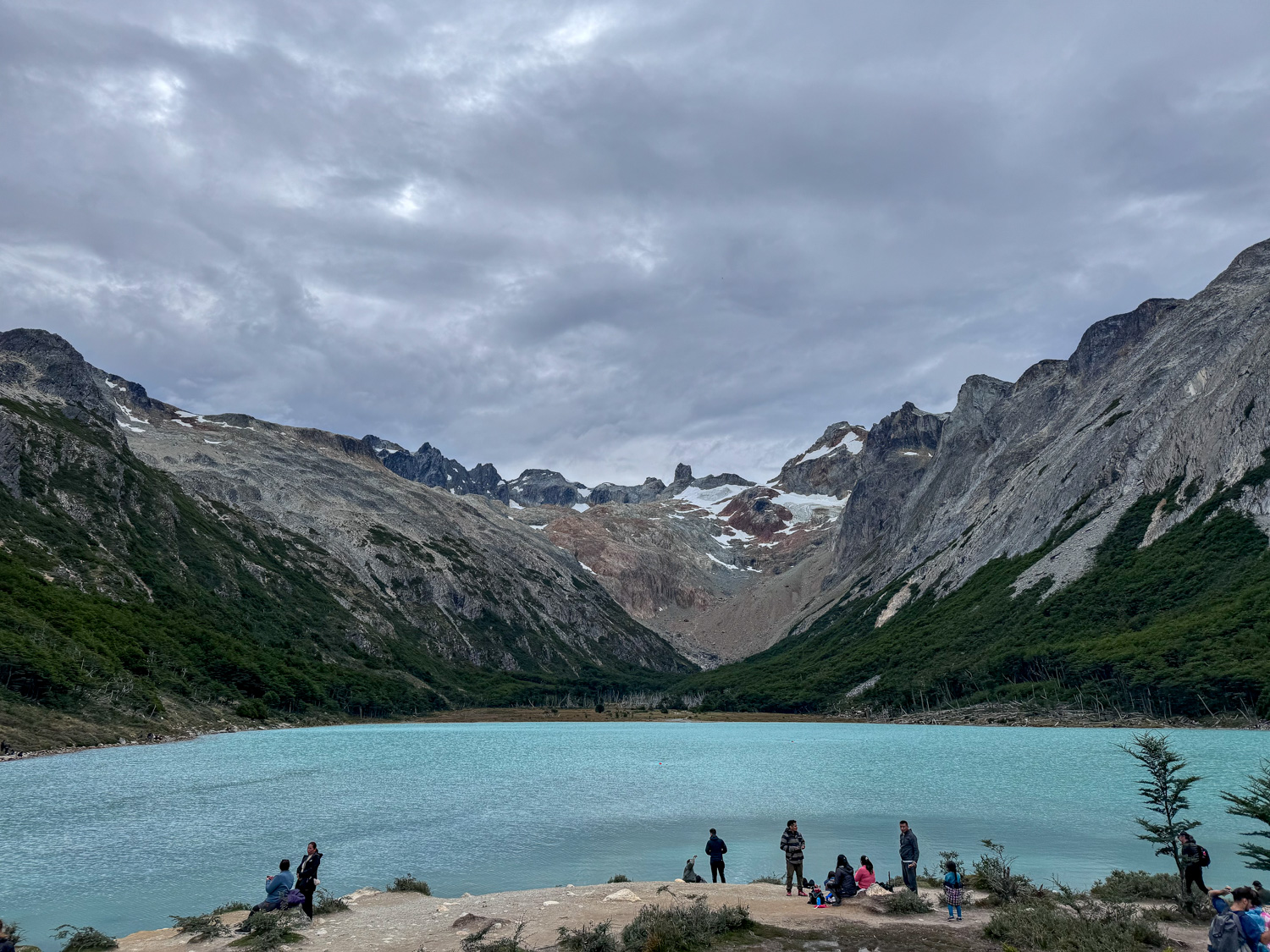
Puerto Madryn
Puerto Madryn is the perfect place for marine wildlife lovers. A little off the beaten track, this city is known for its local marine wildlife, such as seals and whales.
If you’re keen on whale watching, visit Puerto Madryn between June and December. This will be your best chance to see the famous Southern Right Whale and, if you’re very lucky, even an orca.
For those not bothered about seeing marine animals, I wouldn’t prioritise visiting Puerto Madryn. To reach here, you’ll either need to get a long coach from Buenos Aires or fly.
Tip: A few hours down the road from Puerto Madryn is Peninsula Valdes. If you pass through in February or March, you might have the chance to see the orcas breaching themselves at Punta Norte to catch seals. This is the only place in the world where this phenomenon takes place.
How to get around Argentina
Argentina is a very large and sparse country. Many of the popular destinations are spread around the country, and travelling by land (if even possible) can take days.
Flying is the most popular way to travel around Argentina, but it isn’t always the most budget-friendly option. If you’re backpacking Argentina, you’ll be pleased to hear there are several other ways to explore the country.
Domestic flights
In general, the best way to get around Argentina is to use domestic flights. This is especially true when travelling from or between destinations such as Mendoza, El Calafate, Buenos Aires, Iguazu Falls and Ushauai.
Most of the major tourist destinations have domestic airports making flying an easy way to get around the country, especially when you are short on time.
Unfortunately, flying in Argentina isn’t always the most budget-friendly. To secure a cheap flight, try to book as far in advance as possible.
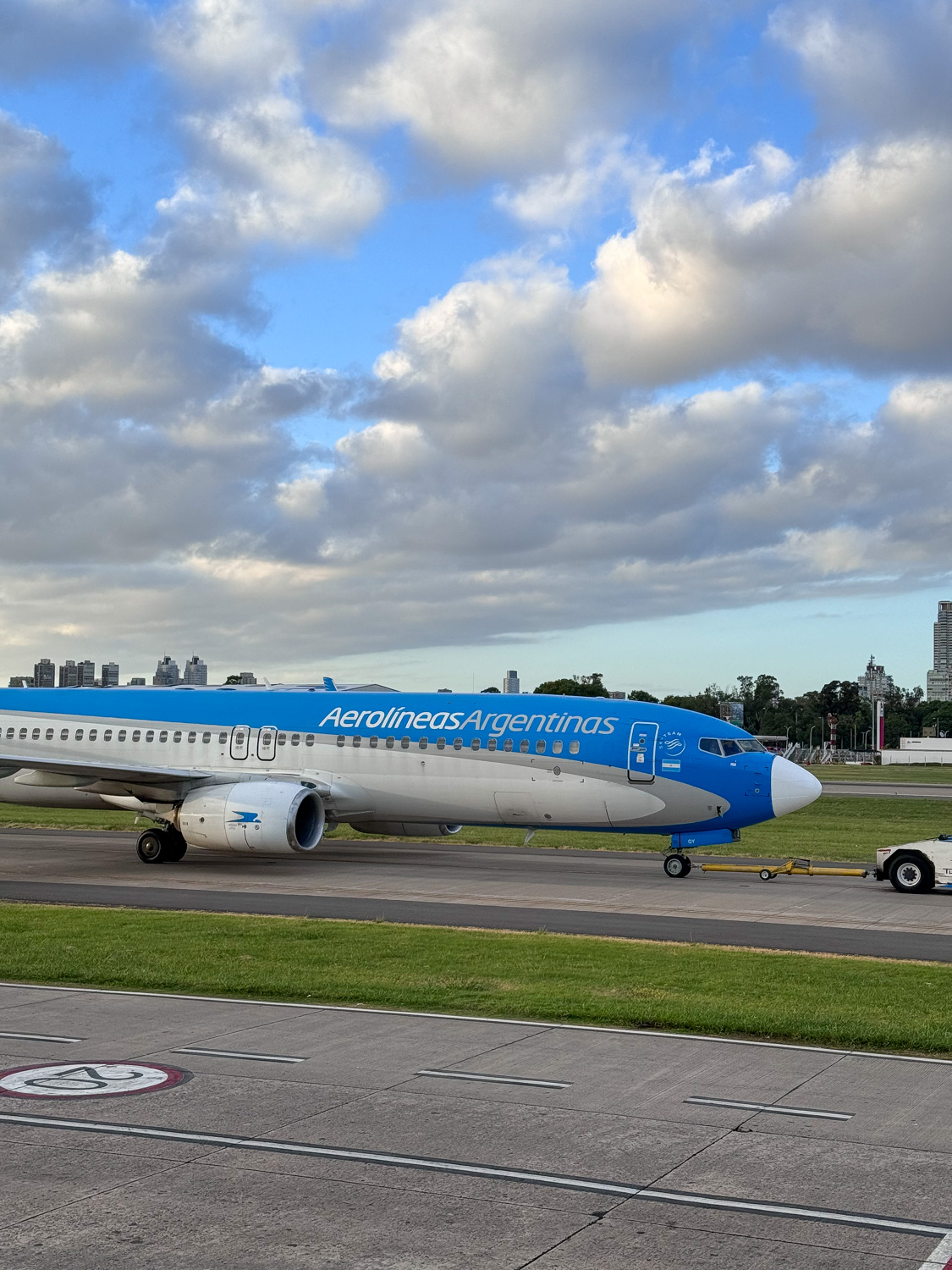
Buses
Alternatively, day and overnight buses are popular options when travelling between several tourist destinations. In fact, if you’re travelling around Patagonia or to/from Chile, catching a bus is the easiest and cheapest way to get around.
There is a good coach network connecting the Patagonia region. This includes El Calafate, El Chalten, Punta Arenas, Puerto Natales and Bariloche.
Most major towns in Argentina have a bus station, but be prepared for some long drives. For example, if you want to avoid flying altogether, your bus journey from Buenos Aires to Iguazu Falls takes almost an entire day.
Of course, travelling by bus is a great way to see a country and can be beneficial on some routes. You can make overnight stops at beautiful destinations such as Puerto Madryn when travelling by bus from Buenos Aires to Ushuaia.
Tip: Buses in Argentina aren’t always the cheapest. I’d suggest using BusBud to find the cheapest option.
By car
Hiring a car is a popular way to explore the Patagonia region of both Chile and Argentina. It allows you to explore at your own pace and stop wherever you want.
It’s important to note that hiring a car to drive the entirety of Argentina would be a big undertaking. I’m not sure I would suggest driving from Buenos Aires to El Calafate, for example!
However, it’s a great option for exploring specific regions such as Patagonia.
It’s been my dream to go on a road trip through Patagonia, and I can’t wait to go back to do so!
Rental Cars is a great way to find affordable car rental in Patagonia.
Where to begin your backpacking trip
When planning your backpacking itinerary for Argentina, one of the biggest decisions to make is deciding where to start.
Flying into Argentina
If you’re flying in internationally, the best place to start is Buenos Aires. Most international flights flying into Argentina are to Buenos Aires, and this is generally the cheapest airport to fly into.
Even if your final destination is Patagonia or Ushuaia, I’d still highly recommend spending at least one day in Buenos Aires. The city is a great taster of this fantastic country and well worth exploring. It also might be logistically easier to find cash and a SIM card in Buenos Aires.
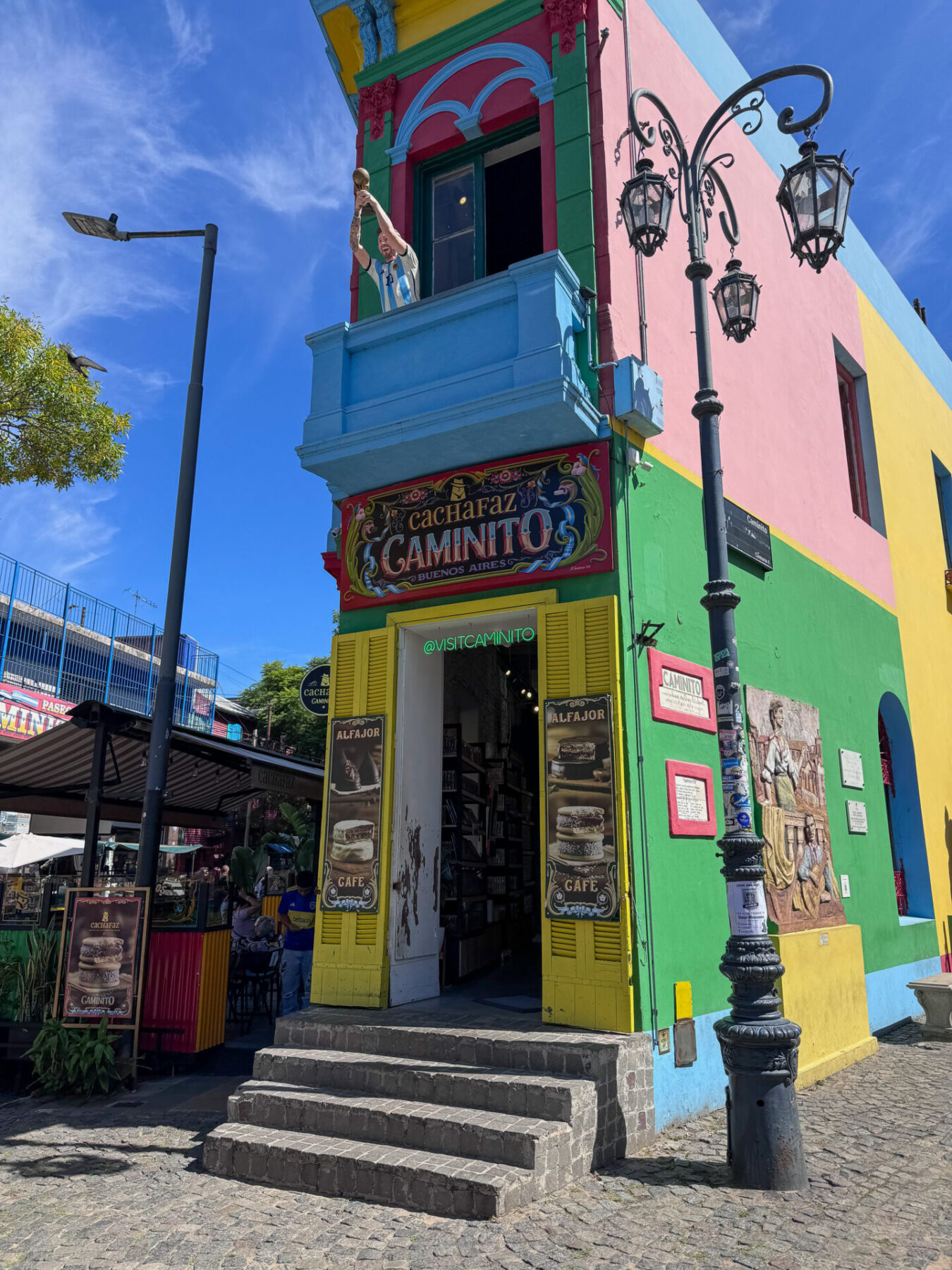
From Chile
If you’re backpacking around Patagonia from Chile, you might find the best starting point is El Calafate.
This lively town is the gateway to the incredible Los Glaciares National Park, home to the spectacular Perito Moreno Glacier and the iconic Mount Fitz Roy.
El Calafate is well connected by bus to Puna Arenas and Puerto Natales in Chile. It’s much cheaper to get a coach between these destinations than to fly. It’s also a popular option to visit Torres del Paine National Park before or after visiting Los Glaciares.
From Brazil
If you’re backpacking Brazil before heading to Argentina, it could be a good option to cross the border at Iguazu Falls.
You can explore the Brazilian side of the falls before crossing the border into Argentina.
From here, you can fly down to Buenos Aires to continue your backpacking trip in Argentina.
Accommodation in Argentina
Argentina is filled with unique and wonderful accommodation options. Unfortunately, it isn’t the cheapest country and accommodation can take up a big chunk of your budget.
Hostels
For most people who are backpacking in Argentina, hostels tend to be the best option. Hostels are not only a great way to travel on a budget but also make it a lot easier to meet new people. This might be more important for those travelling solo in Argentina.
If you prefer your own space, many of the hostels I stayed in during my time in Argentina also offered private rooms.
One thing to note about hostels in Argentina is that they tend to be on the pricier side, especially in Patagonia. The hostels also aren’t the most modern. This isn’t a big deal, but if you’re used to the fancy hostels of Southeast Asia, you might be in for a bit of a shock.

Estancias
Staying at an Estancia is a must on any trip to Argentina. These farm stays are a great insight into local life and a nice alternative to your typical hotel or hostel.
Staying at an Estancia can be very expensive, especially those located on the tourist route. However, meals and activities such as horseriding are often included. It’s also a once-in-a-lifetime experience so while expensive, you might never get the chance to experience it again.
Is Argentina safe for solo travellers?
Argentina is generally a safe place for solo travellers. I spent a month travelling around by myself with no issues. However, it’s always important to be aware of your surroundings and take precautions, especially when travelling solo.
The capital of Argentina, Buenos Aires, has its problems. Some areas of the city have a high crime rate, and petty crimes against tourists are common.
I never once felt unsafe in Buenos Aires, but I stayed in the tourist areas and didn’t walk alone at night. If you are travelling solo in Buenos Aires, try to follow some basic safety guidelines, including:
- Stick to the tourist areas
- Lock valuables away
- Don’t flaunt any expensive equipment or jewellery
- Don’t walk around with your phone out
- Don’t walk alone at night
- Trust your gut
- Be aware of scams
The most common crime you will encounter in Buenos Aires is phone snatching or pick-pocketing, especially in the busy areas of the Microcenter or La Boca. Always keep your belongings close to you and try to keep them out of sight.
Away from the big cities, crime in Argentina tends to be low. Patagonia itself is a very safe area. During my two weeks in El Chalten, El Calafate and Ushuaia, I never once felt unsafe and encountered many other solo travellers.
Hiking solo is also common in Patagonia. Many of the trails are well-maintained and popular with other visitors.
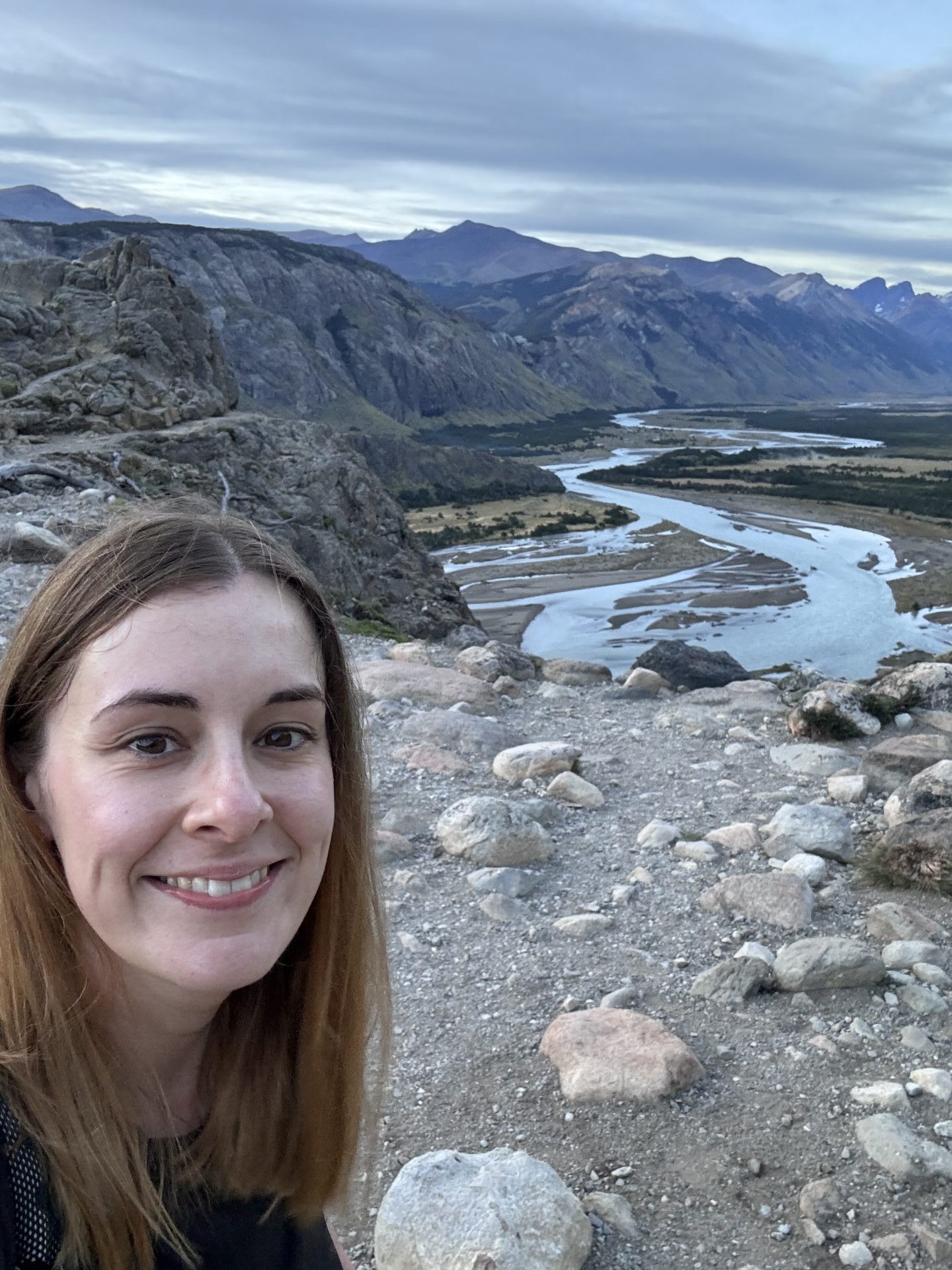
Argentina backpacking budget
NOTE: Argentina’s economy is very unstable. As of 2024, it is experiencing record inflation (200%) and is dropping against the USD.
With Argentina’s economy so unstable and inflation at a record high, prices are constantly changing. While I was in the country, many menus removed their prices as they were going up every single week. With all of this in mind, I’ve used USD as a rough guide for prices and budgeting. However, please note this may very quickly change.
Argentina was once a cheaper country to travel to, but in recent years, prices have skyrocketed. If you’re on a budget, you might find it a tricky country to travel in.
Quick summary – suggested budget (solo traveller)
Accommodation: $30 USD per day (hostels)
Food: $20 USD per day
Transport: $250 USD (buses and taxis) per trip
Activities: personal choice
Accommodation
Accommodation is the most expensive part of backpacking Argentina. I stayed in hostels throughout my trip and while they were reasonably priced in Buenos Aires, the prices were incredibly high in Patagonia. The hostels are also quite basic, so it feels like your money doesn’t go very far.
If you’re happy to stay in hostels, I would budget at least $30 USD per night. For private rooms, you could be looking at as much as $150 USD away from Buenos Aires.
Food and drink
Food and drink are reasonably priced in Buenos Aires. It’s certainly not the cheapest place in the world, but it’s a lot cheaper than Europe. You can eat at a nice restaurant and try local steak for around $30 USD per person, but you can eat at cheaper places for a lot less. You can also find local bottles of wine which were reasonably priced at around $12 USD.
In Patagonia, the food and drink are incredibly expensive. A coffee can set you back as much as $5, and a simple pastry from a bakery could be $4 USD.
The supermarkets in Buenos Aires were also not as cheap as I was expecting, especially in Patagonia.
If you’re visiting several places in Argentina, I would budget at least $20 USD per day for food and drink. You can do it cheaper than this in the likes of Buenos Aires, but this budget will give you flexibility.
Transport
Domestic flights and long coaches in Argentina can be very expensive. My one-hour flight from El Calafate to Ushuaia cost me $180 (this was booked very last minute).
Buses also tend to be more expensive than normal in Argentina. Depending on where you plan to visit, I suggest budgeting at least $250 USD for travel over a month. This will cover buses between the main popular areas and perhaps even a flight if you book far enough in advance.
If you’re planning to fly everywhere during the peak season, you’ll need a bigger budget.
Activities
Argentina is not cheap when it comes to day trips and activities. For example, hiking on the Perito Moreno Glacier will cost a few hundred dollars.
As the economy in Argentina is so unstable, prices are constantly changing, so I’ve chosen not to list them below. However, if you want to do some of the most popular activities in Argentina, including watching a Tango show, visiting Iguazu Falls, visiting the Perito Moreno Glacier, cruising on the Beagle Channel, and a day trip to Tierra del Fuego, I’d suggest budgeting at least $500 USD.

Food in Argentina
I was really surprised by the food in Argentina. It might not be the most creative and flavoursome food in the world, but it’s delicious nonetheless.
Here are a few foods worth trying while backpacking in Argentina:
- Steak: Argentina is famous for its steak and can be found all over the country at a reasonable price.
- Empanadas: Empanadas are another local dish in Argentina. These small pieces of pastry are stuffed with delicious fillings. They’re normally a cheap and filling snack.
- Choripan: I made the mistake of not eating Choripan until my last day in Argentina. Don’t ask me why! This baguette stuffed with sausage is absolutely delicious and very affordable.
- Medialunas: These small pieces of sweet pastry, similar to croissants, are often served with coffee.
- Pastries and cakes: Pastries and cakes in Argentina are incredible. Argentinians take their sweet foods very seriously, and bakeries are found in every town. Cinnamon buns are a particular favourite.
- Asado: They love their meat in Argentina, and an Asado is the best way to experience this. Asado roughly translates to BBQ.
- Provoleta: This is an Argentina form of provolone cheese that is loved around the country. If you visit Buenos Aires, the provoleta I had at Hierro Parrilla Palermo literally changed my life (not to be dramatic).
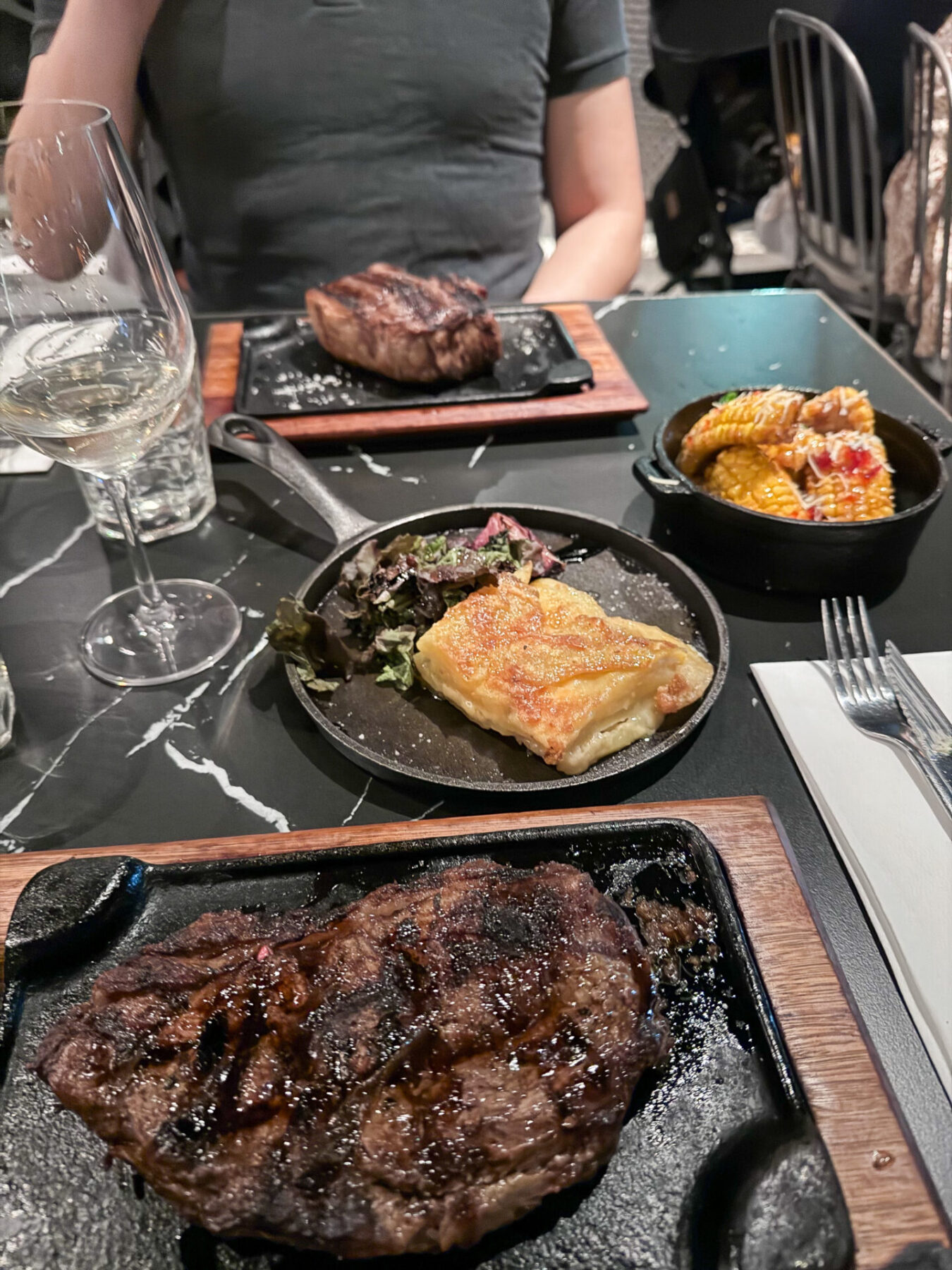
Backpacking Argentina: packing essentials
Packing for any backpacking trip is never easy, but with the range of outdoor activities and diverse weather, packing for Argentina can be particularly challenging.
I’ve already shared a packing guide for Patagonia, but here are some specific items that may come in use for your trip to Argentina as a whole:
- Water bottle: Aside from Buenos Aires, most of the tap water in Argentina is drinkable (always check this locally). I also found that many of the hostels had a cooler with filtered water. Remember to pack a water bottle to save money and reduce waste.
- Travel towel: Most of the hostels I stayed in didn’t offer towels to borrow or even rent. Make sure you have a travel towel to use in hostels.
- Hiking gear: Argentina is one of the best hiking destinations in all of South America. Even if you’re not a big hiker, you’ll no doubt find yourself in need of hiking gear such as boots, layers and a waterproof jacket.
- Crossbody bag: Petty crimes such as pick-pocketing are sadly common in Buenos Aires. I recommend using a small crossbody bag. This way, your valuables, such as your phone and wallet, will always be in your eyeline.
- Versatile clothes: Anything goes when it comes to the weather in Argentina. From the humidity and heavy rain in Buenos Aires to the freezing winds of Patagonia, you really can encounter anything in this wild country. I’d suggest packing a mix of clothes to ensure you’re covered for all eventualities. Consider items such as long skirts and shorts for Buenos Aires, as well as warmer jeans and hiking trousers for Patagonia. Don’t forget layers for your upper body.
- Sun protection: The sun in Argentina is strong. Even on cloudy days, I managed to burn. Remember to pack plenty of sun protection, including a cap, SPF and long-sleeved tops.
- Suitable shoes: I always find shoes the hardest thing to pack! You think you need shoes for hiking, going to the beach, walking around a city, and going out at night. The list goes on. If you’re backpacking Argentina, you’ll likely only have space for one or two pairs. Prioritise comfortable shoes for walking around the city and sensible shoes for hiking.
- Padlocks: If you’re staying in hostels, remember to pack padlocks so you can lock your belongings away during the day.
- Travel adapter: Argentina uses type C and I plugs. I found the type I plug to be more common (the same as in Australia). One of my must-have packing items for any backpacking trip is my handy Universal Travel Adapter. You can buy these on Amazon, and they work in most countries around the world.

Paying for things in Argentina
Paying for things in Argentina caught me a little off guard. While it’s straightforward enough, it’s still important to do a bit of research beforehand.
The currency in Argentina is the Argentine Peso. Some places do accept USD, but the exchange rate is very poor so it’s not recommended.
Important note: The Argentinian economy is incredibly unstable. I’ve done my best to ensure the below is as accurate as possible, but please bear in mind that things may change quickly.
Paying by credit card in Argentina
Paying by credit card can be hit-and-miss in Argentina. I found that most places in Buenos Aires accept card, but not everywhere. There were a few cafes, restaurants and bars I visited that only took cash, even in Buenos Aires.
Away from Buenos Aires, it’s important to always have cash to hand. In areas such as El Chalten, cash is normally the preferred way to pay. In fact, both of my hostels in El Calafate and El Chalten insisted I paid with cash pesos and not by card.
The other thing to note is that paying for credit card can often incur a fee and doesn’t always have the best exchange rate. I’d suggest checking the current Mastercard or Visa exchange rate against the Blue Dollar rate to see if you’d save money by paying in cash.
Paying by cash in Argentina
Using cash is the best way to pay for things in Argentina. It’s accepted everywhere, and if you use Western Union to withdraw money, you’ll get the best exchange rate.
However, getting cash in Argentina is annoyingly complicated. Most ATMs only allow you to withdraw up to $20 at a time, and there’s normally a hefty fee associated with this. The exchange rate is also poor.
The best way to withdraw money in Argentina is to use Western Union. This global bank offers a Blue Dollar exchange rate for tourists, meaning you get more for your money. Once you’ve downloaded the Western Union app, you can choose to send yourself Argentinian Pesos. You then go to your nearest Western Union and collect the money.
I HIGHLY recommend getting as much cash as you can in Buenos Aires. The Western Union in El Calafate has very small withdrawal limits and often runs out of money.
Note: Mastercard and Visa have clocked on to the Western Union exchange rate and are trying to match it as closely as they can. I still found it cheaper overall to pay with cash, but it’s worth checking the current exchange rates to see which is best for you. Just be aware that you’ll likely need some cash while in Argentina.

Tipping in Argentina
I found tipping in Argentina to be similar to that of Europe. It’s customary to leave a 10% tip when dining in restaurants or when you’ve received good service. This isn’t normally added to your bill automatically, so it’s customary to leave cash on the table or hand it to your server.
It’s also common to tip tour guides who have provided exceptional service.
SIM Cards in Argentina
Buying a SIM card in Argentina is a sensible idea. I found that while WiFi was widely available, it didn’t always work and wasn’t the most reliable.
Nowadays, it’s usually easier to buy an eSim, which means you don’t need to worry about buying a physical SIM card. However, this wasn’t the case in Argentina. While using an eSim is logistically easier, it’s a lot more expensive than buying a physical SIM.
I would recommend using Claro while in Argentina. They have some great deals available for tourists that provide a large amount of data at a low price.
You can buy the SIM card at a Claro store. Remember to bring your passport to activate the SIM.
Did you enjoy this post on backpacking Argentina? Share on social media or save for later.
Share this guide

